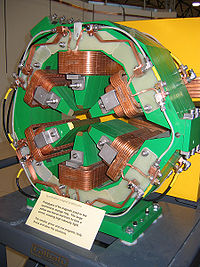Sextupole magnet

Okay, kiddo, have you ever played with magnets and noticed how they stick to metal surfaces and each other? Well, there are different types of magnets that can do different things, and one of them is called a sextupole magnet.
A sextupole magnet is a special type of magnet that is used in big machines called particle accelerators, which are used by scientists to study tiny particles like atoms and subatomic particles. These magnets are usually shaped like a cylinder or a donut and have six poles, which means they have six different areas where the magnetic field is strongest.
The reason scientists use sextupole magnets in particle accelerators is because they can help control the path that the particles take as they zoom around inside the machine. Think of it like a race track. Just like how a driver might use the steering wheel to turn left or right, sextupole magnets can be turned on and off to change the direction of the particles as they move around the particle accelerator.
These magnets work by creating a magnetic field that is stronger in some areas and weaker in others. The stronger areas pull the particles in one direction, while the weaker areas push them in another direction. By strategically placing and controlling these magnets, scientists can control the path that particles take and even focus them into a tight beam for experiments.
So, in summary, a sextupole magnet is a special type of magnet used in particle accelerators to control the path of particles by emitting a strong magnetic field in certain areas, much like how a steering wheel controls the direction of a car on a race track.
A sextupole magnet is a special type of magnet that is used in big machines called particle accelerators, which are used by scientists to study tiny particles like atoms and subatomic particles. These magnets are usually shaped like a cylinder or a donut and have six poles, which means they have six different areas where the magnetic field is strongest.
The reason scientists use sextupole magnets in particle accelerators is because they can help control the path that the particles take as they zoom around inside the machine. Think of it like a race track. Just like how a driver might use the steering wheel to turn left or right, sextupole magnets can be turned on and off to change the direction of the particles as they move around the particle accelerator.
These magnets work by creating a magnetic field that is stronger in some areas and weaker in others. The stronger areas pull the particles in one direction, while the weaker areas push them in another direction. By strategically placing and controlling these magnets, scientists can control the path that particles take and even focus them into a tight beam for experiments.
So, in summary, a sextupole magnet is a special type of magnet used in particle accelerators to control the path of particles by emitting a strong magnetic field in certain areas, much like how a steering wheel controls the direction of a car on a race track.
Related topics others have asked about:
